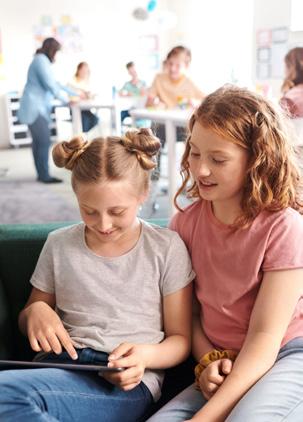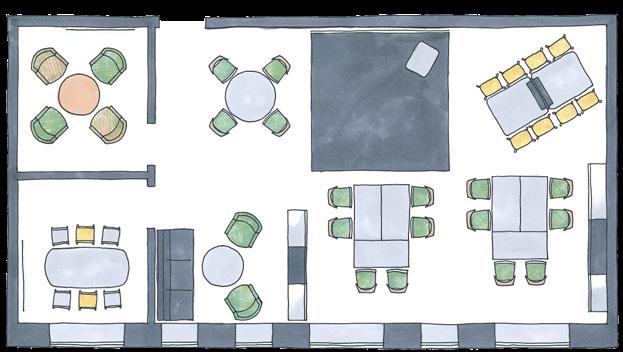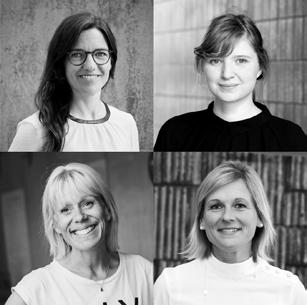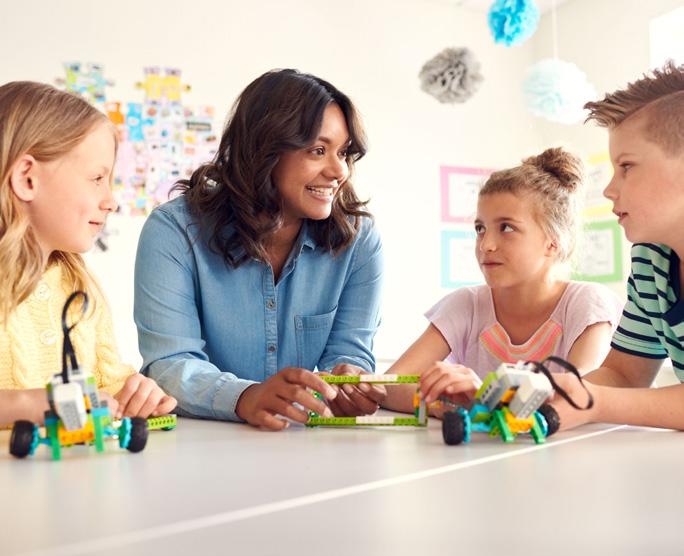
7 minute read
Elisabet Ingemarsson
Pedagogy and technology change – but furnishing learning spaces that support the individual and the students who are to work in them creates the very best opportunities for active learning. Both now and in the future. This is the view of Elisabet Ingemarsson, principal of the innovative Sjölunda school, a municipal school for children from preschool to year 6 in Lidköping, Sweden.
Elisabet and her colleagues have realised their shared vision of activity-based learning and multi-modal work which takes the individual’s abilities and needs as its starting point. In the classroom, the children have the opportunity to develop and choose their own place for different tasks.
A CLASSROOM FOR ACTIVE LEARNING “For me, the fundamental thing is that the classroom should activate the children and enable them to choose between different workplaces. I have designed a classroom consisting of a large home base supplemented by two group rooms with project tables and soft seating. The classroom offers four completely different ways of working.”
The students can choose to work on the floor, which is covered with a soft, comfortable carpet that frames the whole room and signals to the children that it’s okay to sit here.
I have designed a classroom for preschool to 6 that offers four completely different ways of working.
In the classroom there is an education table with chair, which supports a more traditional way of working. This is supplemented by a high table that enables the students to stand up and work – they can also choose to sit at the high table on a high stool. The fourth parameter is soft seating in the form of easy chairs and sofas. “These four spaces signal to the children that it’s OK to change their position and way of working in discussion
with their teacher. I have also chosen to abandon the classic teacher’s desk. Instead, there is a desk where the teacher can set up their computer and put their work material down, and then move freely around the classroom.”
Elisabet Ingemarsson’s starting point when she created her ideal classroom was her extensive experience.
“I didn’t actively look for research that supports my theories, but through my proven experience I have seen how the children react to different environments. I also base my work on Reggio Emilia’s philosophy of the importance of a good learning environment, what the learning environment signals to the students and how they can conquer the learning environment. In Sjölunda, we think we’ve achieved a really good result, where the students have a great interaction with the teachers and the environment. We’ve seen that when we work with activity-based learning, we get good work processes in the room, since the children find their own way of learning. If a student is lying on the floor reading a book, it isn’t actually the position itself that’s important, but the learning process that’s taking place. In this way we can draw out the best from each student.”
PHYSICAL, SOCIAL AND PEDAGOGICAL ENVIRONMENT IN HARMONY Traditionally, in Swedish schools, we have worked a lot with benches and desks - there were not so many work surfaces for the children to go to. In view of the fact that some children have a lot of movement in their bodies, this kind of environment can sometimes be a problem. They need alternatives, Elisabet thinks.
“Visitors to Sjölunda sometimes ask us whether the children fight to sit in the easy chairs, but that isn’t the case. Because there are so many different types of environments to go to, there’s never any competition. Some children also learn really quickly what suits them - freedom of choice becomes a route to increased self-awareness.” “Overview and transparency are really important in my classroom. As a teacher, I want to be able to scan the environment with my eyes so that I have a good overview and can see what’s happening. This also gives the children security. That’s why my classroom has no hidden or forgotten corners, and no shelves more than a metre high that can obstruct the view. My eyes have to be able to meet the children’s. But it’s important to emphasise that my ideal classroom is marked by strong leadership from the teacher. This means that the children aren’t allowed to jump around just as they like, but they choose a place and way of working in discussion with their teacher. It’s the teacher’s task to use their leadership to guide the children around the environment. The interaction between the students, the teacher and the environment is the key to a good learning environment.”
When Elisabet furnishes her classroom, she starts with the accessibility model, where she attaches equal importance to the physical, social and pedagogical environment. These three factors interact in the interior design. In the home base, the combination of different tables, carpets and soft seating makes it easy for the individual student to choose the place that suits the current task. The group room with a project table supports concentrated collaboration and the group room with soft seating is a room that encourages conversation and dialogue.
“The fact that the environment also supports the social aspect and gives both quietness for study and security in relations with other students and the teacher is really important. When we carry out surveys among the students, a quiet atmosphere for study comes high up on their wish list, so I’ve chosen a number of acoustic solutions in the form of sound-absorbing furniture and carpets,” says Elisabet, who has noticed that children often seek out Social environment
DEVELOPMENT
Physical environment INTERACTION
The accessibility model
Pedagogical environment
5 TIPS!
1. An activity-based classroom makes it possible to meet the needs of the individual student and utilise every individual’s full potential.
2. Four different ways of working – sitting on the floor, sitting at a table, standing at a table or soft seating – make it easy for the students to choose the place that suits the moment.
3. Flexible interior design solutions support the pedagogical need and facilitate the use of new technology.
4. Focus on ergonomics: seat ergonomics, acoustics and a calm, harmonious design with muted colours.
5. The activity-based classroom is founded on strong leadership, where the teacher has a good overview and can guide the students through activities and places.
the soft elements when they are exploring a new environment for the first time.
“We’ve become really good at looking after adults’ office environments, but the idea of ergonomics has never really caught on in the children’s world. Now we’ve begun to talk about the environment as the third pedagogue. We see the environment as an important teaching resource.”

FLEXIBLE INTERIOR DESIGN AND THE RIGHT COLOURS An important element of the classroom’s design is that Elisabet has chosen to have storage units on castors, which are easy to move around, making the room flexible. Depending on what the student group is like, their age and how they work, the room can quickly be modified.
“We’ve chosen colours on the basis of how children react to them, and what signals the colours send out. It’s important that the room is not perceived as messy. So we’ve chosen unified colours for the rooms – white laminate and the same type of wood throughout as a calm, neutral basis. Then we bring in colour in the form of textiles and covers, for example blue and green. A calm, stable environment with unified colours sends out good signals to the students – many children can react really badly if there are too many sensory impressions. For us, it’s important for all children to have the same opportunities – to create a school for all students.”

ORIGO A series of school tables available in many different heights and shapes to suit all needs. Table tops with sound-absorbing characteristics for a good acoustic environment and the possibility of adding castors for smooth movement. At the side there is a hook for a jacket or a bag.
11 m
XPECT HIGH An embracing student chair that gives the student their own space and creates security in the classroom. The flexing back encourages movement and allows a high level of concentration to be maintained for longer periods. Suspendable to facilitate cleaning and stackable for efficient use of space.
SPACE LECTERN A lectern with castors, easy for the teacher to roll around the room. Gives a functional work surface and practical storage unit, within easy reach.

66 sq m
VAGABOND DUO A functional and creative table with two heights, for standing or seated work. A perfect table for collaboration. Lockable castors make it easy to move or put in a fixed position – all for a flexible environment.
MOTUS Stool in two heights, with castors for smooth transportation. The curved, upholstered seat makes the stool comfortable. The design allows for different ways of sitting.
INVITO Sturdy, comfortable easy chair with an embracing back. Perfect for comfortable individual seating with time for focus or in a group for collaborating with other students.






